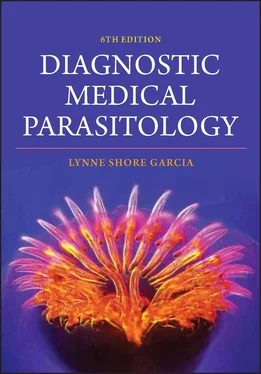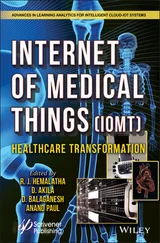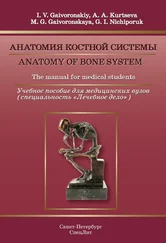Lynne Shore Garcia - Diagnostic Medical Parasitology
Здесь есть возможность читать онлайн «Lynne Shore Garcia - Diagnostic Medical Parasitology» — ознакомительный отрывок электронной книги совершенно бесплатно, а после прочтения отрывка купить полную версию. В некоторых случаях можно слушать аудио, скачать через торрент в формате fb2 и присутствует краткое содержание. Жанр: unrecognised, на английском языке. Описание произведения, (предисловие) а так же отзывы посетителей доступны на портале библиотеки ЛибКат.
- Название:Diagnostic Medical Parasitology
- Автор:
- Жанр:
- Год:неизвестен
- ISBN:нет данных
- Рейтинг книги:3 / 5. Голосов: 1
-
Избранное:Добавить в избранное
- Отзывы:
-
Ваша оценка:
- 60
- 1
- 2
- 3
- 4
- 5
Diagnostic Medical Parasitology: краткое содержание, описание и аннотация
Предлагаем к чтению аннотацию, описание, краткое содержание или предисловие (зависит от того, что написал сам автор книги «Diagnostic Medical Parasitology»). Если вы не нашли необходимую информацию о книге — напишите в комментариях, мы постараемся отыскать её.
Diagnostic Medical Parasitology — читать онлайн ознакомительный отрывок
Ниже представлен текст книги, разбитый по страницам. Система сохранения места последней прочитанной страницы, позволяет с удобством читать онлайн бесплатно книгу «Diagnostic Medical Parasitology», без необходимости каждый раз заново искать на чём Вы остановились. Поставьте закладку, и сможете в любой момент перейти на страницу, на которой закончили чтение.
Интервал:
Закладка:
It is also important for the physician to know the efficacy of any diagnostic technique for parasite recovery and eventual diagnosis. Our approach to testing is undergoing continuous review, particularly within the current health care environment and cost-containment initiatives. The issue of patient care becomes particularly important when we begin to examine the number and types of compromised patients now being seen in all facilities. The increased publicity concerning immunocompromised patients has led to a greater awareness of parasitic infections in this patient population, regardless of the original cause of the immune deficiencies. Many of these patients with immune system defects are particularly at risk, whether because of previously acquired infections that have remained latent for many years or because of susceptibility to new infections. Many of these infections may present with unusual symptoms, and some are relatively new disease entities or those that are less commonly encountered (microsporidiosis, granulomatous amebic encephalitis, and infection with Cyclospora cayetanensis).
Often in other areas of microbiology, therapy is begun on the basis of patient history and symptoms. This approach is generally not recommended or used in cases of parasitic infection. Thus, the understanding of the characteristics of any parasitic infection (general geographic range, life cycle, clinical disease, diagnostic methods, therapy, epidemiology, and control) and the use of appropriate diagnostic procedures accompanied by a complete understanding of the limitations of each procedure become very important. Because of this approach to patient care, the general consensus among individuals within the field of diagnostic medical parasitology is that the use of certain incomplete procedures may result in incorrect information for the physician and may ultimately compromise patient care.
The main emphasis should be on the importance of understanding and recognizing potential parasitic infections, submitting the appropriate number and type of clinical specimens, knowing what procedures may provide confirmation of the diagnosis, and recognizing the implications and limitations of information provided to the physician. With the current emphasis on the development and use of molecular methods, understanding the benefits and limitations of these procedures will be critical to patient care outcomes. If there is an incomplete understanding of the requirements for high-quality diagnostic testing, incomplete information will be transmitted to the clinician. It is the responsibility of both the laboratory and the clinician to develop a greater awareness of the importance of these requirements.
References
1. Garcia LS (ed). 2010. Clinical Microbiology Procedures Handbook, 2nd ed. ASM Press, Washington, DC.
2. Isenberg HD (ed). 2004. Clinical Microbiology Procedures Handbook, 2nd ed., p. 9.0.1–9.10.8.3. ASM Press, Washington, DC.
3. Isenberg HD (ed). 1995. Essential Procedures for Clinical Microbiology. ASM Press, Washington, DC.
4. Garcia LS, Johnston SP, Linscott AJ, Shimizu RY. 2008. Cumitech 46, Laboratory procedures for diagnosis of blood-borne parasitic diseases. Coordinating ed, Garcia LS. ASM Press, Washington, DC.
5. Garcia LS, Smith JW, Fritsche TR. 2003. Cumitech 30A, Selection and use of laboratory procedures for diagnosis of parasitic infections of the gastrointestinal tract. Coordinating ed, Garcia LS. ASM Press, Washington, DC.
6. Committee on Education, American Society of Parasitologists. 1977. Procedures suggested for use in examination of clinical specimens for parasitic infection. J Parasitol 63:959–960.
7. Parasitology Subcommittee, Microbiology Section of Scientific Assembly, American Society for Medical Technology. 1978. Recommended procedures for the examination of clinical specimens submitted for the diagnosis of parasitic infections. Am J Med Technol 44:1101–1106.
8. College of American Pathologists. 2012. Commission on Laboratory Accreditation Inspection Checklist. College of American Pathologists, Chicago, IL.
9. Clinical and Laboratory Standards Institute. 2005. Procedures for the Recovery and Identification of Parasites from the Intestinal Tract, 2nd ed. Approved guideline M28-A2. Clinical and Laboratory Standards Institute, Wayne, PA.
10. Clinical and Laboratory Standards Institute. 2005. Protection of Laboratory Workers from Occupationally Acquired Infection, 3rd ed. Approved guideline M29-A3. Clinical and Laboratory Standards Institute, Wayne, PA.
11. Clinical and Laboratory Standards Institute. 2000. Laboratory Diagnosis of Blood-borne Parasitic Diseases. Approved guideline M15-A. Clinical and Laboratory Standards Institute, Wayne, PA.
12. Clinical and Laboratory Standards Institute. 2005. Procedures for the Recovery and Identification of Parasites from the Intestinal Tract. Approved guideline M28-A2. Clinical and Laboratory Standards Institute, Wayne, PA.
13. Clinical and Laboratory Standards Institute. 2004. Clinical Use and Interpretation of Serologic Tests for Toxoplasma gondii. Approved guideline M36-A. Clinical and Laboratory Standards Institute, Wayne, PA.
14. Clinical and Laboratory Standards Institute. 2012. Clinical Laboratory Safety. Approved guideline GP17-A3. Clinical and Laboratory Standards Institute, Wayne, PA.
15. Clinical and Laboratory Standards Institute. 2009. Training and Competence Assessment. Approved guideline GP21-A3. Clinical and Laboratory Standards Institute, Wayne, PA.
16. Clinical and Laboratory Standards Institute. 2011. Clinical Laboratory Waste Management, 3rd ed. Approved guideline GP5-A3. Clinical and Laboratory Standards Institute, Wayne, PA.
17. Code of Federal Regulations. 1987. Update May 27, 1992. Title 29, parts 1910.1200 and 1910.1296. U.S. Government Printing Office, Washington, DC.
18. Code of Federal Regulations. 1989. Title 29, part 1910.106. U.S. Government Printing Office, Washington, DC.
19. Code of Federal Regulations. 1989. Title 29, part 1910.1200. U.S. Government Printing Office, Washington, DC.
20. Code of Federal Regulations. 1989. Title 29, part 1910.1450. U.S. Government Printing Office, Washington, DC.
21. Garcia LS. 2009. Practical Guide to Diagnostic Parasitology, 2nd ed. ASM Press, Washington, DC.
22. Joint Commission. 2013. Survey Activity Guide for Health Care Organizations, 2013. The Joint Commission, Chicago, IL.
23. Garcia LS (ed). 2013. Clinical Laboratory Management, 2nd ed. ASM Press, Washington, DC.
| 2 | Collection, Preservation, and Shipment of Fecal Specimens |
| Safety Fresh-specimen collection Collection of the specimen Number of specimens to be collected (standard recommendation) Number of specimens to be collected (pros and cons of various options) Collection times Specimen type, specimen stability, and need for preservation Preservation of specimens Preservatives Formalin MIF SAF Schaudinn’s fluid Schaudinn’s fluid containing PVA (mercury base) Schaudinn’s fluid containing PVA (copper base, zinc base) Single-vial collection systems (other than SAF) Universal Fixative (TOTAL-FIX) Use of fixatives Quality control for stool fixatives Procedure notes for use of preservatives Procedure limitations for use of preservatives Shipment of diagnostic specimens, biological products, etiologic agents, or infectious substances Documentation |
This chapter discusses various collection methods that are available for specimens suspected of containing parasites or parasitic elements. When a laboratory selects its collection methods, the decision should be based on a thorough understanding of the value and limitations of each. One of the most important aspects of specimen collection is that the final laboratory results based on parasite recovery and identification will depend on the initial fixation of the organisms ( 1– 3). Unless the appropriate specimens are properly collected and processed, these infections may not be detected ( 1). Considering the current era of cost containment and review of clinical relevance of laboratory information generated, specimen rejection criteria have become more important within the context of all diagnostic microbiology procedures. Diagnostic laboratory results based on improperly collected specimens may require excessive expenditures of time and supplies and may also mislead the physician. As a part of any overall total quality management or continuous quality improvement program for the laboratory, the generation of test results must begin with stringent criteria for specimen acceptance or rejection.
Читать дальшеИнтервал:
Закладка:
Похожие книги на «Diagnostic Medical Parasitology»
Представляем Вашему вниманию похожие книги на «Diagnostic Medical Parasitology» списком для выбора. Мы отобрали схожую по названию и смыслу литературу в надежде предоставить читателям больше вариантов отыскать новые, интересные, ещё непрочитанные произведения.
Обсуждение, отзывы о книге «Diagnostic Medical Parasitology» и просто собственные мнения читателей. Оставьте ваши комментарии, напишите, что Вы думаете о произведении, его смысле или главных героях. Укажите что конкретно понравилось, а что нет, и почему Вы так считаете.












